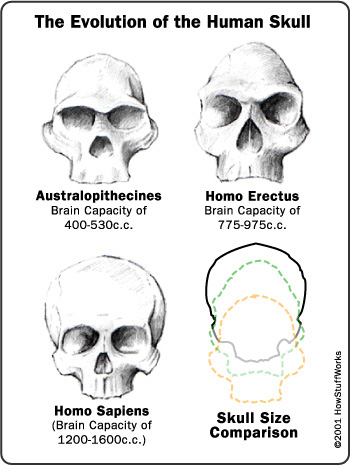
5 Cultural
evolution – How we relate to one another
Outline | Labor | Instinct | Summary
“it fairly reeks of theory of mind”
Vocabulary
Soft inheritance or acquired traits, learning,
ethos, social behavior, fear group dynamics, kin & kinship, fight or flight
vs. stay & play, socialization, sanity & pathology, taboo, adaptive
vs. maladaptive actions, reciprocity, retribution, conditioning, transference,
neurosis, cooperation vs. coercion.
Outline
. The
Evolution of Culture { 69
.
Early
human culture { 72 Human family tree
1.
2.5 million years of stone tools (Figure 4.1) {
73
2.
250,000 years ago
a.
the Acheulian progressed to Mesolithic
b.
from flake to sophisticated tools
.
The
Great leap forward { 74 J. Diamond’s
phrase for “revolution”
.
The
roots of warfare { 99
.
Culture
since farming { 105
.
Family
Definition and Structure {108
. From
Family to States {110
.
Norms
& Mechanisms of Cultural Evolution {115
John Locke & Karl Marx.
Natural resources X Human resources = technology
Land times Labor equals capital
See land. labor, & wealth as creators of value.
fight or flight vs. stay & play
norepinephrine [1]
The Great leap forward { 74
Summary
“Understanding cultural evolution (and how our
brains evolved to make it possible) is both fascinating and critical to an
understanding of how homo
sapiens (from a common ancestor with Homo
erectus) achieved global dominance.” p. 97
Steven
Mithln
1. capacity to picture the outcome of future actions {animal
2. fantasm – capacity to ignore
& reject reality{ human
3. “leap of imagination,”
Lyell, Bohr, Einstein, etc. { genii
p. 98
“natural selection could be the mechanism responsible for the diversity
of life” required
such an “imaginative leap.”
98
“theory of
mind”
“aware of the thoughts and
intentions of others.”
98
“aggressive behavior” “warfare”
98
development of “goal directedness”
Steps in achieving an end: planning
discussion
cooperation
coercion
99
The roots of warfare { 99
human “passive aggression.”
“Requires
a lot of imagination”
intra-group directed aggression humans share with other
animals. chimps
Gombe males and chimpanzee troops
1971-1977
“the Kaskala males had wiped out
the Kahama coomunity.”
“Goodall thinks that they probably were deliberately
homicidal,”
“living in an area of recently and dramatically restricted
habitat.”
100
“Frequent intra-community violence among people . .
. or warfare . . . is nearly ubiquitous among human societies.”
101
“defend well-marked
territorial areas and kills of prey animals.”
101
why don’t elephants and
dolphins reveal such behavior?
101
“models to inform us about
the likelihood that we have violent ‘natures.?”
“much less common among
bonobos than among chimpanzees,”
“females initiating
cross-community grooming and even copulation.”
101
“Infanticide is unreported in bonobos, but it does
occur in chimps.”
101
“work among other primates
suggests the environmental
flexibility of aggressive behavior.”
102
baboons were studied
The males change behavior when aggressive males are
not present.
102
“resource shortages and
population pressures were involved in the generation of conflict.”
102
stages of violence have been
proposed in studies of 132 cultures
102-103
homo erectus 1 million years ago –
spears
cooperative hunting could reduce such intra-group violence
agricultural revolution – permitted military
specialization
103
“consideration of entire groups as enemies”
“societies have gone to war
more often as they became more structured into classes, maintained cadres of professional
soldiers, and developed more complex technologies.”
103
There is no evidence of genetic determined violent
character traits since friendship is also manifest across populations.
103-104
“There is a paradox here–war is
undesirable from the viewpoint of most sane people, yet warfare persists. “
Not instinctual or behaviorally predetermined
“Cultural evolution is too complex for that.”
105
The rapid change wrought by the agricultural
revolution, which led to vastly greater stores of non-genetic information and
transformed the social organizations . . .”
105
“12,000 to 7,000 years ago
in eight remote and detached
places around the world
1. New Guinea
2. China
3. Persia (Iran) Caucasus
4. Central & South America,
5. North America
6. Africa
7. Northern India
8. Southeast Asia
Jericho,
11,400 years ago
“began
intervening to shape nature”
“That
agricultural revolution . . . represents much more than a new stage in human
intergroup violence. It launched our species into an entirely new arena of
cultural evolution, one that did away forever with the long-term human
situation of everyone being the possessor of almost all the non-genetic
information of his or her society.”
105-106
“a coherent picture of
genetic evolution”
culture is equated with non-genetic evolution
106
There is no unified “theory of culture” to
match “natural selection’s predictive power
106
non-genetic information is responsible for human’s
“profound power to affect all life on Earth.”
106
“Human
culture has been evolving for some 6 to 7 million years
107
“gradually began to master the manufacture of tools.”
107
twenty to fifty is the “optimal number” of people in an effective human group
“relationship between the size of the brain’s perceiving
thinking structure (the neo-cortex) and the factor that bind primate societies
together.”
107
“kinship” “often
using chemical clues”
Humans rely primarily on
sight and odor clues
107
“kin selection is one possible explanations for the evolution
of some kinds of altruistic behavior in people:’
107
Family Definition and Structure {108
“social learning” is
“learning by observing others.”
108
“cooperating more with one another in their productive and
reproductive lives than they do with other individuals.”
108
“Na
people of China’s matrilines” matrilineal
descent lines
“the necessity of intercourse to produce children is
recognized but, the genetic contribution of the male is not.”
108-109
“women frequently have dozens of lovers.”
109
Segmentation
Clans
emerge as the initial separating mechanism in developing gatherer/hunter
societies
109
From Family to States {110
surpluses built-up by agricultural production led to further segmentation
or
reinforced segmentation already / underway
110
The post-agricultural evolution lead to the reinforcement of nation states
“The
human experience as a small group animal is largely over today for everyone”
111
“the language of pseudokinship is
widespread within states”
111
“three kinds of circumscription” the theme and theory of how nation-states develop
1. geographic or environmental barriers
2. resource and
3. social
112
more frequent warfare and the
rise of statehood
114
•
Norms & Mechanisms of Cultural Evolution {115
They
are examples of the modifications of norms
Diversification
of family structures, agricultural revolution, the changing face of warfare
118
“Norms provide cultural... viscosity that can help sustain adaptive behavior and retard detrimental changes in society....”
“change is itself is a daunting problem.”
115
“stickiness can inhibit the introduction and spread of
beneficial behaviors.”
115
"...the evolution of technological norms will generally be more rapid than that of ethical norms."
117
"Technological changes are usually tested promtly against environmental conditions–"
differential speeds of cultural evolution between essential and auxiliary features of tools
Polynesian
canoe designs are more divergent than the structural components necessary for navigation.
Suggest
conservation of survival related qualities and elaboration of non-essential patterns
117
“favoring conservation
cultural features that helped avoid disaster slowed the differentiation of structural
characteristics.”
117

“Understanding
cultural evolution (and how our brains evolved to make it possible) is both
fascinating and critical to an understanding of how homo sapiens (from a common ancestor with erectus) achieved global dominance.”
118
